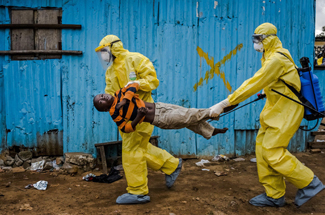By Mark Ellis

Officials have tried to diminish public concerns about the worst outbreak of Ebola in history through one consistent message: Ebola can only be transmitted by direct contact with blood or bodily fluids. Yet several world-class scientists at the forefront of studying Ebola suggest these assurances may be premature, and the virus may be transmitted via aerosol droplets.
Dr. C.J. Peters, who dealt with a 1989 outbreak of the virus among research monkeys in Virginia and later led the CDC’s most far-reaching study of Ebola’s transmissibility in humans, said he would not rule out the possibility that it spreads through the air in tight quarters, according to a story in the L.A. Times.
“We just don’t have the data to exclude it,” Peters told the Times. He is currently researching viral diseases at the University of Texas in Galveston.
Peters, whose CDC team studied 27 cases that emerged during a 1995 Ebola outbreak in the DR Congo, said that while most could be tied to contact with infected patients or their bodily fluids, “some” infections may have occurred via “aerosol transmission.”
Dr. Philip K. Russell, a virologist who oversaw Ebola research while heading the U.S. Army’s Medical Research and Development Command, and who later led the government’s massive stockpiling of smallpox vaccine after the Sept. 11 terrorist attacks, also said much was still to be learned. “Being dogmatic is, I think, ill-advised, because there are too many unknowns here,” he told the Times.
“Scientifically, we’re in the middle of the first experiment of multiple, serial passages of Ebola virus in man…. God knows what this virus is going to look like. I don’t,” Dr. Russell said.
Tom Skinner, a spokesman for the CDC in Atlanta, said health officials are conducting ongoing lab analyses to assess whether the present strain of Ebola is mutating in ways that would require the government to change its policies on responding to it. The results so far have not provided cause for concern, he said.
The researchers interviewed by the L.A. Times said there is sufficient cause to question U.S. officials’ assumptions in several areas.
First, can Ebola be transmitted through the air? In late 1989, virus researcher Charles L. Bailey supervised the government’s response to an outbreak of Ebola among several dozen rhesus monkeys used for research in Reston, Virginia.
What Bailey discovered from the incident aroused his suspicion that the current strain of Ebola afflicting humans might be spread through small liquid droplets driven through the air by coughing or sneezing.
“We know for a fact that the virus occurs in sputum and no one has ever done a study [disproving that] coughing or sneezing is a viable means of transmitting,” he said. Unqualified assurances that Ebola is not spread through the air, Bailey said, are “misleading.”
“Those monkeys were dying in a pattern that was certainly suggestive of coughing and sneezing — some sort of aerosol movement,” Bailey said. “They were dying and spreading it so quickly from cage to cage. We finally came to the conclusion that the best action was to euthanize them all.”
Skinner of the CDC, who cited the Peters-led study as the most extensive of Ebola’s transmissibility, said that while the evidence “is really overwhelming” that people are most at risk when they touch those who are sick or their bodily fluids, “we can never say never” about spread through close-range coughing or sneezing.
“I’m not going to sit here and say that if a person who is highly viremic … were to sneeze or cough right in the face of somebody who wasn’t protected, that we wouldn’t have a transmission,” Skinner told the Times.
Peters, Russell and Bailey, who in 1989 was deputy commander for research of the Army’s Medical Research Institute of Infectious Diseases, in Frederick, Md., said the primates in Reston had appeared to spread Ebola to other monkeys through their breath.
Another issue is whether airport screenings can consistently detect those who might have Ebola. The CDC maintains the protocols used at West African airports may be depended upon to prevent more infected passengers from reaching the U.S.
But some have suggested that travelers could easily subvert the screening procedures to detect a fever by taking ibuprofen or any common analgesic.
CDC officials also say that asymptomatic patients cannot spread Ebola. But some public health specialists, say there is no proof that a person infected — but who lacks symptoms — could not spread the virus to others, according to the L.A. Times report.
“It’s really unclear,” Michael Osterholm, a scientist at the University of Minnesota who served on the National Science Advisory Board for Biosecurity told the Times. “None of us know.”
Russell, who oversaw the Army’s research on Ebola, said he found the epidemiological data unconvincing.
“The definition of ‘symptomatic’ is a little difficult to deal with,” he said. “It may be generally true that patients aren’t excreting very much virus until they become ill, but to say that we know the course of [the virus’ entry into the bloodstream] and the course of when a virus appears in the various secretions, I think, is premature.”




This may answer several questions….
This may answer several questions you or your Friends may have…..
Nursing staff treating Ebola victims must use self-contained
respirators. The N-95 mask, which is a respirator, is not
self-contained, and may allow the virus to enter the lungs
when the victim vomits, or when the toilet is flushed after
diarrhea. Vomit and diarrhea produce an aerosol which contains
the virus, and can travel long distances.
Comments are closed.